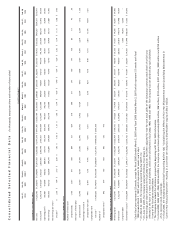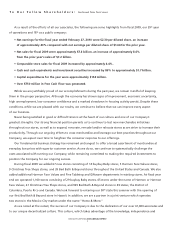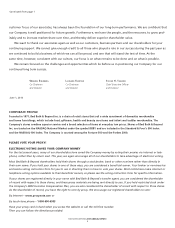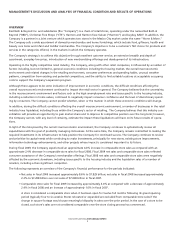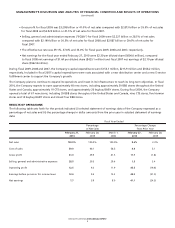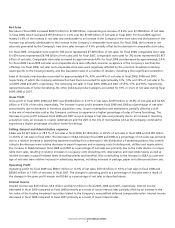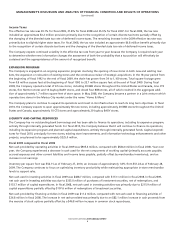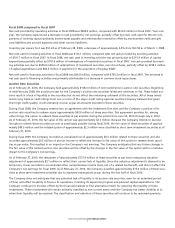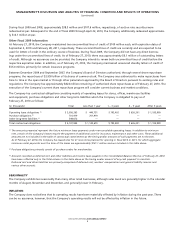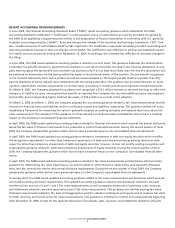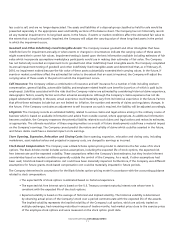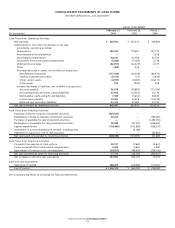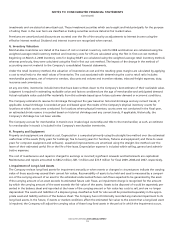Bed, Bath and Beyond 2009 Annual Report Download - page 12
Download and view the complete annual report
Please find page 12 of the 2009 Bed, Bath and Beyond annual report below. You can navigate through the pages in the report by either clicking on the pages listed below, or by using the keyword search tool below to find specific information within the annual report.
MANAGEMENT’S DISCUSSION AND ANALYSIS OF FINANCIAL CONDITION AND RESULTS OF OPERATIONS
(continued)
BED BATH & BEYOND 2009 ANNUAL REPORT
10
reported as Level 3 fair value measurements, which is effective for fiscal years beginning after December 15, 2010. The Company
does not believe the adoption of this guidance will have a material impact on its consolidated financial statements.
REVIEW OF EQUITY GRANTS AND PROCEDURES AND RELATED MATTERS
In June 2006, the Company’s Board of Directors appointed a special committee of independent directors with authority, among
other things, to conduct an investigation with respect to the setting of exercise prices for employee stock options and related
matters. The review identified various deficiencies in the process of granting and documenting stock options and restricted shares.
As a result of the deficiencies, the Company revised the measurement dates for various option grants.
The Company’s past stock option granting procedures have exposed the Company to risk factors that could have an adverse affect
on the Company’s financial condition, including any tax implications relating to the Company’s stock option grants.
CRITICAL ACCOUNTING POLICIES
The preparation of consolidated financial statements in conformity with GAAP requires the Company to establish accounting poli-
cies and to make estimates and judgments that affect the reported amounts of assets and liabilities and disclosure of contingent
assets and liabilities as of the date of the consolidated financial statements and the reported amounts of revenues and expenses
during the reporting period. The Company bases its estimates on historical experience and on other assumptions that it believes
to be relevant under the circumstances, the results of which form the basis for making judgments about the carrying value of
assets and liabilities that are not readily apparent from other sources. In particular, judgment is used in areas such as inventory
valuation, impairment of long-lived assets, goodwill and other indefinitely lived intangible assets, accruals for self insurance, liti-
gation, store opening, expansion, relocation and closing costs, stock-based compensation and income taxes. Actual results could
differ from these estimates.
Inventory Valuation: Merchandise inventories are stated at the lower of cost or market. Inventory costs for BBB, Harmon and
buybuy BABY are calculated using the weighted average retail inventory method and inventory costs for CTS are calculated using
the first in first out cost method.
Under the retail inventory method, the valuation of inventories at cost and the resulting gross margins are calculated by applying
a cost to retail ratio to the retail values of inventories. The cost associated with determining the cost to retail ratio includes: mer-
chandise purchases, net of returns to vendors, discounts and volume and incentive rebates; inbound freight expenses; duty, insur-
ance and commissions.
At any one time, inventories include items that have been written down to the Company’s best estimate of their realizable value.
Judgment is required in estimating realizable value and factors considered are the age of merchandise and anticipated demand.
Actual realizable value could differ materially from this estimate based upon future customer demand or economic conditions.
The Company estimates its reserve for shrinkage throughout the year based on historical shrinkage and any current trends, if
applicable. Actual shrinkage is recorded at year end based upon the results of the Company’s physical inventory counts for loca-
tions at which counts were conducted. For locations where physical inventory counts were not conducted in the fiscal year, an
estimated shrink reserve is recorded based on historical shrinkage and any current trends, if applicable. Historically, the Company’s
shrinkage has not been volatile.
The Company accrues for merchandise in transit once it takes legal ownership and title to the merchandise; as such, an estimate
for merchandise in transit is included in the Company’s merchandise inventories.
Impairment of Long-Lived Assets: The Company reviews long-lived assets for impairment annually or when events or changes
in circumstances indicate the carrying value of these assets may exceed their current fair values. Recoverability of assets to be
held and used is measured by a comparison of the carrying amount of an asset to the estimated undiscounted future cash flows
expected to be generated by the asset. If the carrying amount of an asset exceeds its estimated future cash flows, an impairment
charge is recognized for the amount by which the carrying amount of the asset exceeds the fair value of the assets. Assets to be
disposed of would be separately presented in the balance sheet and reported at the lower of the carrying amount or fair value


